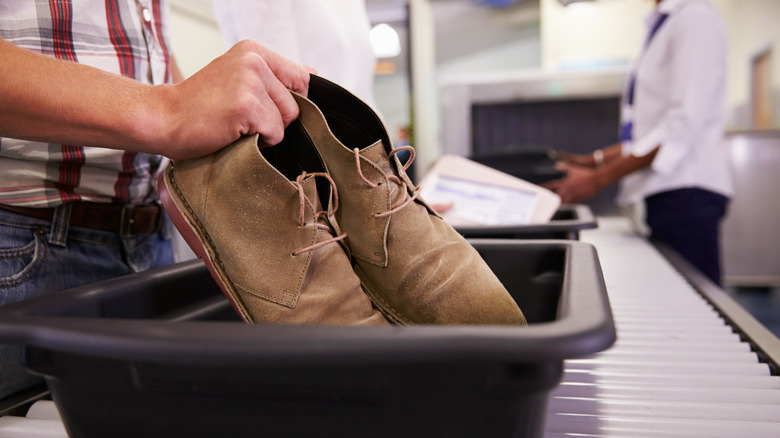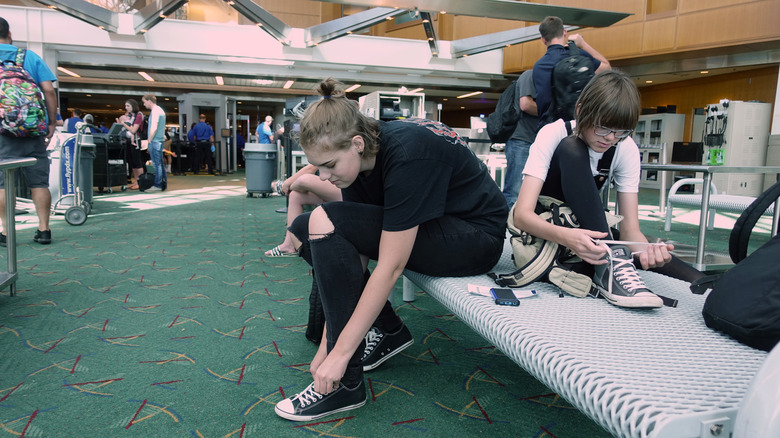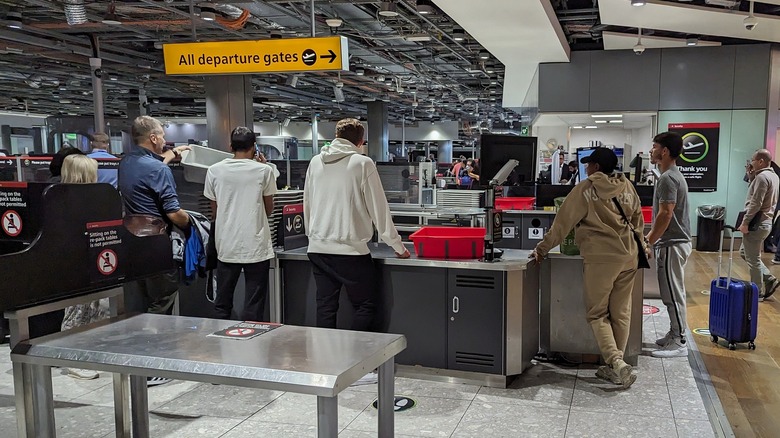Do Any Other Country's Airports Require Shoe Removal While Going Through Security?
If you're passing through a security checkpoint at any American airport, one thing is certain: You have to take off your shoes. Boots, sandals, heels, and everything in between, those bad boys are coming off and going through the X-ray machine. The only exceptions to the rule are passengers 75 and older, children under 12, and those with a TSA PreCheck membership — the rest of us are not so lucky. Many travelers see this as a nuisance at best and might wonder if other country's airports have the same policy. In the U.S., this is standard procedure, but for the rest of the world, the answer is no, not really.
The reason passengers have to take off their shoes is primarily because of Richard Reid. On December 22, 2001, Reid, known as the "shoe bomber," attempted to detonate 10 ounces of explosives hidden in his shoes on an American Airlines flight from Paris to Miami. Passengers and crew restrained him on the plane when they noticed he was struggling to light the fuse. The plane diverted to Logan International Airport in Boston, where Reid was arrested.
However, the shoe rule only came into effect on August 10, 2006, five years later. The last straw was August 9, 2006, when terrorists were plotting to detonate liquid bombs hidden in soda bottles on 10 transatlantic flights — thankfully, their plan was foiled. As a result, the 3-1-1 liquid, gel, and aerosol rule was implemented, and TSA figured, let's check people's shoes as well.
North America, South America, Africa, and Oceania
Shoe removal protocols are influenced by each country's security and threat assessments, which vary from place to place. So, what about the neighbors up north of the U.S., Canada? Unless flying to America from Canada, travelers can keep their shoes on for both domestic and international flights. However, at Edmonton International Airport, for example, steel-toed boots or shoes with metal in their heels have to be removed. Passengers enrolled in the Canadian Air Transport Authority (CATSA) Verified Traveller Program don't have to take their shoes, laptops, or compliant liquids out, similar to TSA PreCheck — but in Canada.
In African countries, security procedures can vary significantly — but they seldom involve shoes. Major international airports in South Africa, such as O.R. Tambo International in Johannesburg, may sometimes require shoe removal, but it's not a consistent practice. In South America, airports generally do not require shoe removal either. Flights departing from Argentina are exempt (unless you set off the metal detector), likewise for Brazil (on a case-by-case basis), and in Mexico, the shoes also stay on.
In Australia, major airports like Sydney and Melbourne may ask passengers to remove their shoes only if they trigger the metal detector. In New Zealand, airports (such as Auckland International) rarely require shoe removal. However, according to New Zealand's Aviation Security Service, if you have boots with metal, they have to go through security, as do shoes that cover above the ankle (with or without metal).
Europe, Asia, and the Middle East
Over in Europe, the European Union has a unified set of security guidelines that do not require removing shoes. However, individual countries, airports, and flights in the EU may have different, case-by-case measures. For example, flights bound for the U.S. and airports in Spain (Barcelona, specifically), Heathrow in the United Kingdom, and Dublin in Ireland have the shoes-off protocol. Security officers may ask for shoes that contain metal, appear thick, or have a boot-like shape to be scanned through the X-ray.
Asian countries have diverse approaches to airport security and shoe removal. Southeast Asian airports like Manila International in the Philippines and Bangkok International in Thailand require passengers to take their shoes off, particularly for international flights. In Japan and South Korea, shoe removal is generally not required except for bulky shoes. However, in China, policies can be more stringent, especially in airports with high international traffic, such as Beijing Capital International Airport and Shanghai Pudong International Airport.
Airports in the Middle East, known for their cool state-of-the-art facilities, also exhibit varied security practices. Dubai International Airport, one of the busiest airports globally, does not require passengers to remove their shoes (unless they contain metal or have heels). Similarly, Hamad International Airport in Doha, Qatar, and Abu Dhabi International Airport in the UAE follow suit, focusing instead on thorough technology-forward scanning and random checks. So, shoes on or shoes off? It depends. In any case, it's always good to be prepared.


